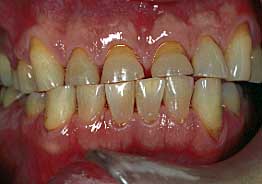Damaged Teeth from Grinding
As we get older, most people assume that the teeth will wear down as part of the aging process. Normally, when we are relaxed, the jaw is in a position where the teeth are not touching. The only time our teeth are actually suppose to touch is when we swallow. This occurs 2000-3000 times each day. Even when we are eating, our teeth don't come together because we have food between them. The only time that we would see severe wear on teeth is due to a malocclusion or a parafunctional habit. A malocclusion is when someone has a bad bite and the teeth don't come together properly.

A parafunctional habit is when teeth come together in a grinding or clenching motion. Usually, grinding or clenching of the teeth occurs at a time when we are unaware of it, such as when we are asleep. Many people will wake up in the morning with a variety of symptoms as a result of teeth grinding or clenching. The grinding and clenching of the teeth is a direct result of the muscles of the jaw and neck trying to place the jaw into a relaxed position. The teeth get in the way of this position, thus we grind or clench. Often times the worn or broken teeth will be restored with crowns or onlays. This results in these restorations eventually failing also. Sometimes, the gums and bone will recede as a result of the parafunctional habit, and teeth will be lost.
Using Neuromuscular dentistry we will get the muscles comfortable before attempting to restore the teeth. Once the relaxed position of the muscles is found, the teeth can be restored to keep the muscles in the relaxed position. This creates a harmonious balance between the muscles and teeth.